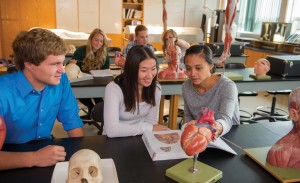The Department of Biology and Microbiology at SDSU has a history of placing students in medical school and other professional programs.
Operating within the human biology major, the pre-professional program offers help for students interested in going on to study medicine, athletic training, chiropractic, dental, mortuary science, occupational and physical therapy, optometry, physician assistant and veterinary medicine.
“We support any student who wants to go to professional school, whether they’re our major or not,†said assistant professor Greg Heiberger, who became the department’s first full-time preprofessional school adviser in 2007. That role is currently filled by Marjoanne Thompson. “If you’re a bio-chem major or you’re an exercise science major, and you want to go to medical school, we’re going to help you get there.†When Heiberger talks to prospective students and their parents, he points out all the features that make the SDSU human biology majors more competitive applicants. Students have access to research opportunities through capstone and many scientists on and off campus; peer mentoring; upper-division classes like cancer biology, immunology and medical microbiology; and a course in human cadaver-based anatomy.
Historically, SDSU students with good grades and an involvement in human cadaver-based anatomy have a higher rate of medical school acceptance. Heiberger points out that of the 4,000 schools in the nation offering a biology major, most don’t offer a course where undergraduate biology students have the opportunity to dissect a human cadaver.
“The reason cadaver-based anatomy is important,†Heiberger explained, “is because it’s the first class every student at every medical school takes. It doesn’t matter if you go to Stanford or the USD Sanford School of Medicine, you’re taking cadaver-based anatomy.â€
Cadaver-based anatomy, along with other high-level human biology courses, aren’t required for admission to medical school. Heiberger compares the higher level courses to advanced placement courses in high school.
“Just like high school AP courses, these upper-division human biology courses won’t help you skip a year of medical school,†Heiberger said, “but when students complete them the transition to med school is much less stressful than it is for other students.â€
Preparation for admission to professional schools goes beyond the classroom to include peer mentoring, an American Medical Student Association club and an MCAT prep course.
Heiberger said in 2003 there were less than 10 SDSU students going on to professional schools. In 2018, a stethoscope ceremony for students going on to professional schools honored more than 50 students with at least 18 of them heading for medical school.
“We’ve had five or 10 years now of just skyrocketing growth,†Heiberger said.
– Dana Hess






